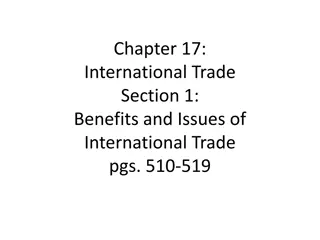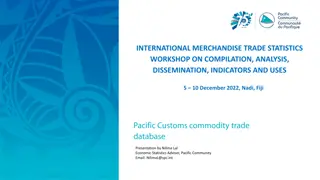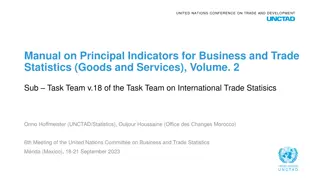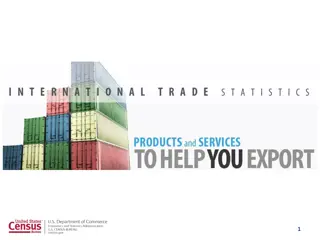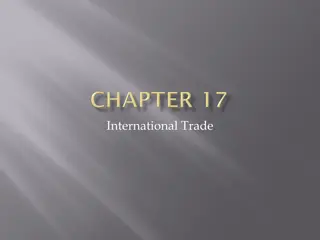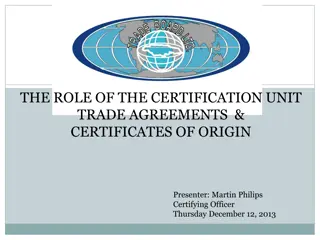Understanding International Trade: Principles and Benefits
Delve into the world of international trade with a focus on absolute and comparative advantage, gains from trade, barriers, and protectionism. Explore the motivation for trade, specialization, and productivity gains. Learn about the basis for trade, including absolute and comparative advantage, and discover the gains that countries can achieve through specialization and trade. Engage in examples illustrating trade concepts to deepen your understanding.
Uploaded on Sep 21, 2024 | 0 Views
Download Presentation

Please find below an Image/Link to download the presentation.
The content on the website is provided AS IS for your information and personal use only. It may not be sold, licensed, or shared on other websites without obtaining consent from the author. Download presentation by click this link. If you encounter any issues during the download, it is possible that the publisher has removed the file from their server.
E N D
Presentation Transcript
Acknowledgments This PowerPoint presentation is based on and includes content derived from the following OER resource: Principles of Microeconomics An OpenStax book used for this course may be downloaded for free at: https://openstax.org/details/books/principles-microeconomics-2e 2
Key Questions What are absolute and comparative advantage? What are the gains from trade? What is intra-industry trade? What are barriers to trade? What do we mean by protectionism What are the major arguments used to justify protectionism? 3
The Motivation for Trade Trade allows us to specialize in the production of goods. Specialization means focusing on the production of a particular good or on a particular stage in the production process of a good. Specialization promotes knowledge, and leads to productivity gains and greater levels of output. 4
The Basis for Trade - Absolute Advantage vs. Comparative Advantage Absolute advantage Means that one country can produce the same good with fewer resources than another country. In other words, one country is more efficient in producing the good. Comparative advantage Means that one country can produce a good at a lower opportunity cost than another country. Recall that opportunity cost as what you give up to get something. 5
The Gains From Trade Refers to the ability of a countries to increase their consumption through specialization and trade. The gains arise from countries specializing in the production of goods in which they have a comparative advantage and trading with other countries that are also specializing. Specialization need not be 100% for gains to accrue. 6
Example: Oil for Corn (1 of 10) In this example, assume that Saudi Arabia and the U.S. both produce and consume oil and corn. Assume also that the only factor of production is labor. Producing one barrel of oil takes 1 hour of labor in Saudi Arabia and 2 hours in the U.S. Producing one bushel of corn takes 4 hours in Saudi Arabia and 1 hour in the U.S. Question: Which country has the absolute advantage in oil; which in corn? 7
Example: Oil for Corn (2 of 10) Assume that both Saudi Arabia and the U.S. have a total of 100 hours of labor to use. Based on per unit labor required for oil and corn, we determine the max. output in each country. See PPFs on the next slide. Note that they are straight rather than bowed. Maximum Production with 100 hours of labor Total barrels of oil Total bushels of corn Country Saudi Arabia 100 25 United States 50 100 8
Example: Oil for Corn (3 of 10) Panel (a): Saudi Arabia can produce 100 barrels of oil and no corn (pt. A) or 25 bushels of corn and no oil (Pt. B) or any combination of oil and corn lying along the PPF (such as Pt. C). Panel (b): The U.S. can produce 50 barrels of oil and no corn (pt. A ) or 100 bushels of corn and no oil (pt. B ) or any combination lying along the PPF (such as pt. C ) 9
Example: Oil for Corn (4 of 10) The opportunity cost of one good is the amount of the other good that must be sacrificed. Based on the PPFs, the opportunity cost of producing a barrel of oil is bushel of corn for Saudi Arabia but 4 bushels of corn for the U.S. The opportunity cost of producing a bushel of corn is 4 barrels of oil for Saudi Arabia but barrel of oil for the U.S. Question: which country has the comparative advantage in oil and which in corn? Opportunity Costs of Oil (in terms of Corn) Corn (in terms of Oil) Country Saudi Arabia 4 United States 2 10
Example: Oil for Corn (5 of 10) Saudi Arabia gives up the lesser amount of corn to produce a barrel of oil. Therefore, Saudi Arabia has a comparative advantage in oil. The U.S. gives up the lesser amount of oil to produce a bushel of corn. Therefore, the U.S. has a comparative advantage in corn. 11
Example: Oil for Corn (6 of 10) Without trade, Saudi Arabia and the U.S. are producing and consuming at points C and C on their PPFs. Assume Saudi Arabia trades 20 barrels of oil to the U.S. for 20 bushels of corn. Is this a good trade for Saudi Arabia? Yes. It s getting 1 bushel of corn for 1 barrel of oil instead of 4 barrels. Question: is it a good trade for the U.S.? Why? Oil (bbl.) Corn (bu.) Before Trade Consumption Saudi Arabia 60 10 United States 20 60 Total 80 70 After Trade Consumption Saudi Arabia 40 30 United States 40 40 Total 80 70 12
Example: Oil for Corn (7 of 10) We can show Saudi Arabia s gains from trade by looking at its PPF. Before trade, Saudi Arabia is producing and consuming at point C on its PPF. After trade, Saudi Arabia can consume at point D, which lies beyond the PPF. 13
Example: Oil for Corn (8 of 10) What just happened? Saudi Arabia and the U.S. specialize (not 100%) in the production of the good in which they have the comparative advantage. They engage in trade. As a consequence, both countries consumption can move beyond their PPF. Specialization and trade has thus led to gains from trade. 14
Example: Oil for Corn (9 of 10) The exchange of 20 barrels of oil for 20 bushels of corn is not the only beneficial trade available to both countries. Both will benefit from trade as long as they can obtain a good from the other at a cost that s less than their domestic opportunity cost. In our example, Saudi Arabia will benefit from trade with the U.S. if it can obtain 1 bushel of corn for less than 4 barrels of oil. The U.S. will benefit from trade if it can obtain a barrel of oil for less than 2 bushels of corn. 15
Example: Oil for Corn (10 of 10) In our example, both Saudi Arabia and the U.S. produce some of each good. Question: What happens to total production if both countries specialize 100% in the good in which they have the comparative advantage? 16
What Happens When One Country Has the Absolute Advantage in All Goods? This is likely to be the case for high-income countries that have better-educated workers, more and better physical capital and the latest technology. However, even in this case both countries can still benefit from trade. Because gains from trade come from specializing in one s comparative advantage. 17
Intra-Industry Trade (1 of 3) The trade described in the example is inter-industry or one-way trade in which countries exchange different goods (oil for corn). In reality, much of world trade involves the exchange of differentiated but similar goods (compact cars for luxury cars) between similar economies. We refer to this as intra-industryor two-way trade. 18
Intra-Industry Trade (2 of 3) Category U.S. Exports ($ bil.) U.S. Imports ($ bil.) Autos $146 $327 Food and Beverages 144 126 Capital Goods 550 551 Consumer Goods 199 558 Industrial Supplies 507 665 Other Transportation 45 55 Source: http://www/bea/gov/newsreleases/international/trade/tradnewsrelease.htm This table shows some of the largest categories of U.S. exports and imports.Note that in some categories, the dollar amount of exports and imports is quite similar. 19
Intra-Industry Trade (3 of 3) Intra-industry trade arises to take advantage of specialization of labor and economies of scale in production of differentiated goods. The more similar countries are in their factor endowments, the more prominent intra-industry trade becomes. 20
Barriers to Trade Despite the benefits of trade, barriers to trade continue to exist and are typically used to protect vested economic, social, and cultural interests. However, the general trend in the last 60 years has been to lower barriers to trade. The average U.S. tariff rate has fallen tremendously since its high of over 50% in the Great Depression. Since 1970, it has been less than 10% and in 2016 was 6%. 21
The World Trade Organization The World Trade Organization (WTO) is committed to lowering barriers to trade. According to its self-description, the WTO is An organization for trade opening. A forum for governments to negotiate trade agreements. A place for governments to settle trade disputes. 22
Protectionism Protectionism refers to government policies that restrict imports by erecting barriers to trade. It is typically advocated as a way to shield domestic industries from foreign competition or prevent the loss of jobs. Protectionism takes a number of forms including tariffs, quotas and nontariff barriers. 23
Protectionism: Tariffs A tariff is a tax placed on goods imported from foreign countries. The tariff is paid by domestic importers but its incidence also falls on domestic consumers who face higher prices for imported goods. The tariff reduces the demand for imported goods, so foreign producers are also affected. Those who may benefit from a tariff include the companies in the industry whose good is being protected as well as their employees. 24
Protectionism: Import Quotas Import quotas place a physical limit on the quantity of a good that can enter a country during a period of time. Quotas are typically established to benefit domestic producer groups subject to competition from foreign producers. The U.S. places import quotas on a number of goods including beef and sugar. 25
Protectionism: Nontariff Barriers Nontariff barriers refer to a host of rules, regulations and inspections that raise the cost of importing goods and thus discourage imports. Examples of nontariff barriers include: Safety standards Labelling requirements. 26
A Demand and Supply Analysis of Protectionism (1 of 3) Those advocating protectionism may see the only consequences of restricting imports as taking sales from foreign producers and giving them to domestic producers. A basic demand and supply analysis of protectionism shows that it can impose significant domestic costs as well. 27
A Demand and Supply Analysis of Protectionism (2 of 3) With free trade, the total supply available equals the sum of domestic supply and imports. Equilibrium is at point A with price at PTrade and quantity at Qd. Domestic suppliers are selling Qs, with the difference, Qd Qs, being covered by imports. 28
A Demand and Supply Analysis of Protectionism (3 of 3) With restricted trade, the supply curve is equal to domestic supply and equilibrium is at point E with price at PNo Tradeand quantity at Q. Domestic suppliers are selling more at a higher price. However, domestic consumers are buying less and paying a higher price. 29
Free Trade, Protectionism and Income Distribution (1 of 2) Moving from no trade to free trade (or, in reverse, from free to no trade) has an effect on the distribution of income. For example, Brazil and the U.S. both grow sugar beets and sugar prices in Brazil are lower. If the two countries begin trading sugar Prices will rise in Brazil, benefitting producers but costing consumers. Prices will fall in the U.S., benefitting consumers but costing producers. 30
Free Trade, Protectionism and Income Distribution (2 of 2) Now assume that at the behest of U.S. producers, the U.S. restricts imports of sugar from Brazil. Prices will fall in Brazil, benefitting consumers but costing producers. Prices will rise in the U.S., benefitting producers but costing consumers. 31
The Effects of Free Trade on Jobs and Wages Advocates of protectionism also see free trade as hurting domestic workers in the following ways: Free trade costs the U.S. jobs Free trade lowers U.S. wages 32
How Does Free Trade Affect Domestic Jobs? Protectionism may save jobs in the protected industry. However, the saved jobs are being subsidized by consumers who pay higher prices for the output of the protected industry. Protectionism can actually cost jobs in unprotected industries. Paying higher prices for goods sold by protected industries means less money to spend on goods from other industries so jobs may be lost in those industries. If the protected good is an intermediate good, downstream firms will face higher resource costs and may produce less and use less labor. 33
How Does Free Trade Affect Domestic Wages? In theory, free trade encourages specialization in production and should lead to higher productivity and thus higher wages. The practical concern is that while free trade likely benefits high-skilled, high-wage domestic workers, it is detrimental to low-skilled, low-wage workers. 34
Arguments for Restricting Trade: Infant Industry The infant industry argument Intent is to block imports for a limited time to give a young domestic industry time to mature and become competitive. However, this policy puts the government in the position of picking winners and may lead to intense lobbying or corruption to gain favored status. Also, it may be difficult to end the protection once it s started. 35
Arguments for Restricting Trade: Anti- Dumping The anti-dumping argument Dumping refers to selling goods at below cost. Imposing tariffs on such goods would raise their price so it would be more in line with actual production costs. Dumping is not allowed by the WTO. Low export prices may be an indication of competition or a supply/demand imbalance rather than dumping. 36
Arguments for Restricting Trade: Environmental Protection The environmental protection argument To avoid the race to the bottom that may occur when goods are produced in countries with the lowest environmental standards thereby pressuring others to reduce their standards. Evidence suggests that other factors may be more important to location decisions. 37
Arguments for Restricting Trade: Consumer Protection The unsafe consumer products argument Goods may be deemed unsafe or unsanitary. The WTO does allow countries to set their own standards. Special interests may push for arbitrary or unnecessarily strict standards as a way to lessen competition. 38
Arguments for Restricting Trade: National Interest (Security) The national interest argument This argument contends that there are compelling national interests against relying on imports of key materials. Examples are oil and strategic materials or technologies that might have national security applications. Many economists regard this argument with skepticism because lobbyists, politicians, and special interests can tout almost any good as vital to national security. 39
Regional Trade Agreements and Organizations Free Trade Area removes all barriers to trade among members but each member retains its own trade policies with non-members. Example is NAFTA (to be replaced by USMCA). Common Market removes all trade barriers among members and harmonizes trade policy toward the rest of the world. Also allows free movement of labor and capital among members. Economic Union like a common market, removes all trade barriers among members, harmonizes trade policy toward the rest of the world and allows free movement of labor and capital among members. In addition, it adopts common fiscal and monetary policies. The European Union is an example. 40
The Tradeoffs of Trade Policy By and large, economists embrace free trade over protectionism Most believe that over time the average person gains from trade in the form of lower prices, greater choice and even better job opportunities. However, job loss and economic disruption in less competitive domestic industries may also occur. Most economists believe it is still better to pursue the gains from trade and to deal with the costs and distributional issues with other policy tools. 41














